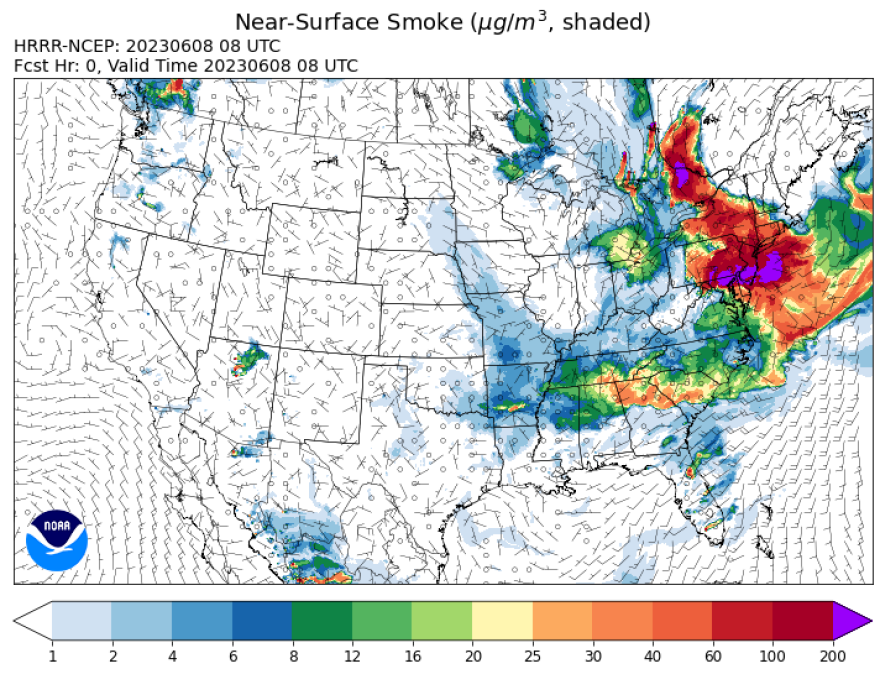BETHLEHEM, Pa. – North Whitehall-based meteorologist Bobby Martrich kicked off his daily video update Thursday with a tone of awe and bewilderment for what had transpired in the region on Wednesday.
“Yesterday was really absolutely ridiculous,” Martrich said. “Anybody who knows me just knows that I hate using sensationalistic headlines or words to describe weather events of any kind.
"Yesterday was nothing short of apocalyptic-looking. It was very eerie. Orange glow across the sky. Very thick, very smoky, very unhealthy.
“I’ve never seen it that bad here, ever, in my life.”
- Air quality in the Lehigh Valley is expected to be a little bit better Thursday, though we're back under a code red air quality alert
- At 5 a.m. Thursday, the air quality in Bethlehem and surrounding areas remained at “hazardous” levels, according to AirNow.gov
- Forecasters say we'll be under the influence of smoke for a few more days before a shift this weekend
Ryan Stauffer, a NASA scientist studying air pollution and ozone, also noted just after midnight on Twitter that "the monitor near Bethlehem, PA will finish the day with an extremely rare 24-hour average 'Hazardous' AQI of over 300. I am quite doubtful this has ever been recorded anywhere in the Northeast and Mid-Atlantic US before."
The monitor near Bethlehem, PA will finish the day with an extremely rare 24-hour average “Hazardous” AQI of over 300. I am quite doubtful this has ever been recorded anywhere in the Northeast and Mid-Atlantic US before.
— Ryan Stauffer (@ryans_wx) June 8, 2023
That tweet came hours after the Lehigh Valley led the nation — at least for a little while — with the worst air quality in the country, measured at 451 AQI in Allentown. Some areas ultimately measured above 500, where the readings from the Department of Environmental Protection max out.
That information came from AirNow, a partnership of the U.S. Environmental Protection Agency, National Oceanic and Atmospheric Administration (NOAA), National Park Service, NASA, Centers for Disease Control, and tribal, state and local air quality agencies.
And the bad news, Martrich said, is that the air quality may not improve substantially in the Lehigh Valley for at least a few more days.
EPAWA's 6/8 and week ahead outlook, covering:
— Bobby Martrich | EPAWA (@epawawx) June 8, 2023
■ Smoke/haze Thursday, how long does it linger?
■ Wraparound showers poss. Thurs/Fri for some
■ A more beneficial rainfall early next week???https://t.co/GNLCxUE7GA
The culprit, he said, has been a blocked pattern all week long that kept an area of low pressure stuck over eastern Maine.
It was able to draw the wind counterclockwise around the low pressure, guiding wildfire smoke from Canada into the Northeast, Great Lakes, the Ohio Valley and down into the Mid-Atlantic.
But the smoke won’t begin to clear until the pattern finally changes, Martrich said, with a shift expected over the weekend as the wind begins to change directions.
He described Thursday – another code red air quality alert day – as “not nearly to the extent” of what transpired Wednesday, with steering flow from that low pressure system pushing concentration of the smoke a little more to our south and west.
READ: The haze and your health: What to do to stay safe while wildfire smoke lingers
WATCH: Live Lehigh Valley weather cam
At 11 a.m. Thursday, the air quality in Bethlehem and surrounding areas remained at “hazardous” levels, according to AirNow.gov.
“As we progress through the morning, this is going to sink further to the South and it’s going to start to dissipate a little bit,” Martrich said, adding that even with the update back to code red, he expected air quality to be "close to 200 AQI by noon."
The National Weather Service forecast is similar, calling for the worst of the air quality early Thursday with widespread haze throughout the day.
Wildfires and Air Quality
Here’s how to protect yourself:
Wildfire smoke can make the outdoor air unhealthy. You should also be aware that some of the smoke from the outdoors can enter your home and make it unhealthy to breathe indoor air, too. Here are actions you can take to reduce exposure, according to the EPA:
Avoid outdoor activities and stay inside
Keep pets inside except for short bathroom breaks
Keep doors and windows closed
Wear a mask, such as an N95 respirator mask
Set your HVAC system to recirculate mode, if possible
Close outdoor dampers on window air conditioners
Avoid activities that create more fine particles indoors, such as frying food, burning candles or spraying aerosol products
Air out your home if air quality improves, even temporarily
Friday is expected to see haze through the morning into the early afternoon, with a chance of showers and thunderstorms on Friday night.
“We’ll still be under the influence of smoke … so anticipate hazy skies and reduced air quality,” the NWS forecast discussion said.
“There should be some reprieve from the smoke through the weekend as the upper level low is forecast to start pushing to the east. This will allow the winds to shift more from the northwest to the southwest, bringing a new airmass to the region.”


